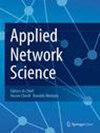Exploring temporal community evolution: algorithmic approaches and parallel optimization for dynamic community detection
IF 1.5
Q3 COMPUTER SCIENCE, THEORY & METHODS
引用次数: 0
Abstract
Abstract Dynamic (temporal) graphs are a convenient mathematical abstraction for many practical complex systems including social contacts, business transactions, and computer communications. Community discovery is an extensively used graph analysis kernel with rich literature for static graphs. However, community discovery in a dynamic setting is challenging for two specific reasons. Firstly, the notion of temporal community lacks a widely accepted formalization, and only limited work exists on understanding how communities emerge over time. Secondly, the added temporal dimension along with the sheer size of modern graph data necessitates new scalable algorithms. In this paper, we investigate how communities evolve over time based on several graph metrics under a temporal formalization. We compare six different algorithmic approaches for dynamic community detection for their quality and runtime. We identify that a vertex-centric (local) optimization method works as efficiently as the classical modularity-based methods. To its advantage, such local computation allows for the efficient design of parallel algorithms without incurring a significant parallel overhead. Based on this insight, we design a shared-memory parallel algorithm DyComPar , which demonstrates between 4 and 18 fold speed-up on a multi-core machine with 20 threads, for several real-world and synthetic graphs from different domains.探索时间群落进化:动态群落检测的算法方法和并行优化
动态(时态)图是一种方便的数学抽象,适用于许多实际的复杂系统,包括社会联系、商业交易和计算机通信。社区发现是一个广泛使用的图形分析内核,具有丰富的静态图分析文献。然而,在动态环境中发现社区是具有挑战性的,原因有两个。首先,时间群落的概念缺乏被广泛接受的形式化,并且只有有限的工作存在于理解社区如何随着时间的推移而出现。其次,增加的时间维度以及现代图形数据的庞大规模需要新的可扩展算法。在本文中,我们研究了基于时间形式化下的几个图形度量的社区如何随着时间的推移而演变。我们比较了动态社区检测的六种不同算法方法的质量和运行时间。我们发现以顶点为中心的(局部)优化方法与经典的基于模块化的方法一样有效。这种局部计算的优点是允许并行算法的有效设计,而不会产生显著的并行开销。基于这一见解,我们设计了一个共享内存并行算法DyComPar,它在具有20个线程的多核机器上演示了4到18倍的加速,用于来自不同领域的几个真实世界和合成图。
本文章由计算机程序翻译,如有差异,请以英文原文为准。
求助全文
约1分钟内获得全文
求助全文
来源期刊

Applied Network Science
Multidisciplinary-Multidisciplinary
CiteScore
4.60
自引率
4.50%
发文量
74
审稿时长
5 weeks
 求助内容:
求助内容: 应助结果提醒方式:
应助结果提醒方式:


